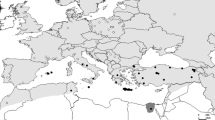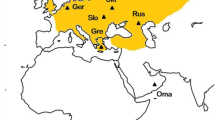Abstract
We investigated the phylogeography and subspecies classification of the ostrich (Struthio camelus) by assessing patterns of variation in mitochondrial DNA control region (mtDNA-CR) sequence and across fourteen nuclear microsatellite loci. The current consensus taxonomy of S. camelus names five subspecies based on morphology, geographic range, mtDNA restriction fragment length polymorphism and mtDNA-CR sequence analysis: S. c. camelus, S. c. syriacus, S. c. molybdephanes, S. c. massaicus and S. c. australis. We expanded a previous mtDNA dataset from 18 individual mtDNA-CR sequences to 123 sequences, including sequences from all five subspecies. Importantly, these additional sequences included 43 novel sequences of the red-necked ostrich, S. c. camelus, obtained from birds from Niger. Phylogeographic reconstruction of these sequences matches previous results, with three well-supported clades containing S. c. camelus/syriacus, S. c. molybdophanes, and S. c. massaicus/australis, respectively. The 14 microsatellite loci assessed for 119 individuals of four subspecies (all but S. c. syriacus) showed considerable variation, with an average of 13.4 (±2.0) alleles per locus and a mean observed heterozygosity of 55.7 (±5.3)%. These data revealed high levels of variation within most subspecies, and a structure analysis revealed strong separation between each of the four subspecies. The level of divergence across both marker types suggests the consideration of separate species status for S. c. molybdophanes, and perhaps also for S. c. camelus/syriacus. Both the mtDNA-CR and microsatellite analyzes also suggest that there has been no recent hybridization between the subspecies. These findings are of importance for management of the highly endangered red-necked subspecies (S. c. camelus) and may warrant its placement onto the IUCN red list of threatened animals.




Similar content being viewed by others
References
Arctander P, Johansen C, Coutellec-Vreto M (1999) Phylogeography of three closely related African bovids (tribe Alcelaphini). Mol Biol 16:1724–1739
Ballard JWO, Whitlock MC (2004) The incomplete natural history of mitochondria. Mol Ecol 13:729–744
Barnett R, Yamaguchi N, Barnes I, Cooper A (2006) The origin, current diversity and future conservation of the modern lion (Panthera leo). Proc Royal Soc B 273:2119–2125
Brown L, Urban E, Newman K (1982) The Birds of Africa, vol 1. Academic Press, London
Brown D, Brenneman R, Koepfli K-P et al (2007) Extensive population genetic structure in the giraffe. BMC Biology 5:57
Coltman DW, Pilkington JG, Pemberton JM (2003) Fine-scale genetic structure in a free-living ungulate population. Mol Ecol 12:733–742
Del-Hoyo J, Elliott A, Sargatal J (eds) (1992) Handbook of the birds of the world. volume 1: Ostrich to Ducks. Lynx Edicions, Barcelona
Dubach J, Patterson BD, Briggs MB et al (2005) Molecular genetic variation across the southern and eastern geographic ranges of the African lion, Panthera leo. Conserv Genet 6:15–24
Evanno G, Regnaut S, Goudet J (2005) Detecting the number of clusters of individuals using the software structure: a simulation study. Mol Ecol 14:2611–2620
Excoffier L, Laval G, Schneider S (2005) Arlequin (version 3.0): an integrated software package for population genetics data analysis. Evol Bioinformatics 1:47–50
Faulkes GC, Verheyen E, Verheyen W, Jarvis JUM, Bennett NC (2004) Phylogeographical patterns of genetic divergence and speciation in African mole-rats (Family: Bathyergidae). Mol Ecol 13:613–629
Flagstad O, Syvertsen PO, Stenseth NC, Jakobsen KS (2001) Environmental change and rates of evolution: the phylogeographic pattern within the hartebeest complex as related to climatic variation. Proc Royal Soc B 268:667–677
Fleischer RC, Olson S, James HF, Cooper AC (2000) The identity of the extinct Hawaiian eagle (Haliaeetus) as determined by mitochondrial DNA sequence. Auk 117:1051–1056
Freeman AR, Machugh DE, McKeown S et al (2001) Sequence variation in the mitochondrial DNA control region of wild African cheetahs (Acinonyx jubatus). Heredity 86:355–362
Freeman-Gallant CR (1996) Microgeographic patterns of genetic and morphological variation in savannah sparrows (Passerculus sandwichensis). Evolution 50:1631–1637
Freitag S, Robinson TJ (1993) Phylogeographic patterns in mitochondrial DNA of the ostrich (Struthio camelus). Auk 110:614–622
Goldstein DB, Pollock DD (1997) Launching microsatellites: a review of mutation processes and methods of phylogenetic interference. Heredity 88:335–342
Hewitt GM (2004) The structure of biodiversity—insights from molecular phylogeography. Front Zool 1(4). doi:10.1186/1742-9994-1-4
Horváth MB, Martínez-Cruz B, Negro JJ, Kalmár L, Godoy JA (2005) An overlooked DNA source for non-invasive genetic analysis in birds. J Avian Biol 36:84–88
Huang Y, Liu Q, Tang B, Lin L, Liu W, Zhang L, Li N, Hu X (2008) A preliminary microsatellite genetic map of the ostrich (Struthio camelus). Cytogenet Genome Res 121:130–136
Jin L, Chakraborty R (1994) Estimation of genetic distance and coefficient of gene diversity from single-probe multilocus DNA fingerprinting data. Mol Biol Evol 11:120–127
Langella O (1999) Populations. 1.2.19. [http://bioinformatics.org/~tryphon/populations/]
Lewis A, Pomeroy DE (1989) A bird atlas of Kenya. Balkema, Rotterdam
Maddison DR, Maddison WP (2001) MacClade 4: analysis of phylogeny and character evolution. Version 4.02. Sinauer Associates, Sunderland
Moodley Y, Bruford MW (2007) Molecular biogeography: towards an integrated framework for conserving pan-african biodiversity. PLoS ONE 2:e454
Muwanika VB, Nyakaana S, Siegismund HR, Arctander P (2003) Phylogeography and population structure of the common warthog (Phacochoerus africanus) inferred from variation in mitochondrial DNA sequences and microsatellite loci. Heredity 91:361–372
Ostrowski S, Massalatchi MS, Mamane M (2001) Evidence of a dramatic decline of the red-necked ostrich Struthio camelus camelus in the Aïr and Ténéré National Nature Reserve, Niger. Oryx 35:349–352
Page R (1996) TreeView: an application to display phylogenetic trees on personal computers. Comput Appl Biosci 12:357–358
Partridge T, Wood B, de Menocal P (1995) The influence of global climate change and regional uplift on large-mammalian evolution in eastern and southern Africa. In: Vrba ES, Denton GH, Partridge TC (eds) Paleoclimate and evolution with emphasis on human origins. Yale University Press, London, pp 331–355
Pritchard JK, Stephens M, Donnelly P (2000) Inference of population structure using multilocus genotype data. Genetics 155:945–959
Raymond M, Rousset F (1995) GENEPOP (version 1.2): population genetics software for exact tests and ecumenicism. J Hered 86:248–249
Robinson TJ, Matthee CA (1999) Molecular genetic relationships of the extinct ostrich, Struthio camelus syriacus: consequences for ostrich introductions into Saudi Arabia. Anim Conserv 2:165–171
Rohland N, Pollack JL, Nagel D et al (2005) The population history of extant and extinct hyenas. Mol Biol Evol 22:2435–2443
Ruokonen M, Kvist L (2002) Structure and evolution of the avian mitochondrial control region. Mol Phylogenet Evol 23:422–432
Seddon PJ, Soorae PS (1999) Guidelines for subspecific substitutions in wildlife restoration projects. Conserv Biol 13:177–184
Stamatakis A, Hoover P, Rougemont J (2008) A rapid bootstrap algorithm for the RAxML web servers. Syst Biol 57:758–771
Swofford DL (2003) PAUP*. Phylogenetic analysis using parsimony (* and other methods). version 4.0. Sinauer Associates, Sunderland
Tang B, Huang Y, Lin L et al (2003) Isolation and characterization of 70 novel microsatellite markers from ostrich (Struthio camelus) genome. Genome 46:833–840
Acknowledgments
Fieldwork was funded by the Sahara Conservation Fund, Saint Louis Zoo, Smithsonian National Zoological Park, Niger’s Ministry of Environment, San Diego Zoo’s Wild Animal Park, AZA Conservation Endowment Fund, and Disney’s Animal Kingdom; and laboratory analyses by Friends of the National Zoo and the Center for Conservation and Evolutionary Genetics. We thank Niger’s Ministry, the Directorate General of Environment, T. J. Robinson, and Dr. Maikano for assistance in the field, and Nancy Rotzel, Laura Morse, Frank Hailer and Emily Latch for help with logistics and/or analysis.
Author information
Authors and Affiliations
Corresponding author
Electronic supplementary material
Below is the link to the electronic supplementary material.
Rights and permissions
About this article
Cite this article
Miller, J.M., Hallager, S., Monfort, S.L. et al. Phylogeographic analysis of nuclear and mtDNA supports subspecies designations in the ostrich (Struthio camelus). Conserv Genet 12, 423–431 (2011). https://doi.org/10.1007/s10592-010-0149-x
Received:
Accepted:
Published:
Issue Date:
DOI: https://doi.org/10.1007/s10592-010-0149-x




